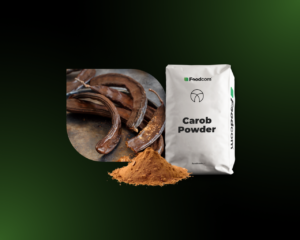- Weather disruptions and contract instability in Turkey, Georgia and Azerbaijan are pushing up hazelnut prices and limiting their availability.
- Paraguay is strengthening its position as a stable supplier of chia seeds in the rapidly growing functional food and supplement market.
- Weather problems in Turkey and demand pressure in Uzbekistan are driving up prices for dried apricots and increasing risks in long supply chains.
- Globally, we are seeing growing demand for palm oil and record soybean exports from Brazil, while new trade agreements in Europe are changing the rules of the game for food producers.
Welcome Partners!
Welcome back to our newsletter!
Supply shocks, contract changes and rising prices – 2025 is changing the global supply landscape. From hazelnuts and chia seeds to dried apricots, in this issue we look at the key ingredients that are under pressure. Strategic sourcing is no longer a choice – it’s a competitive advantage. We highlight the disruptions and opportunities to watch out for in the current climate.
Let’s see what else has happened recently in the plant products market!
Hazelnuts
The hazelnut market has entered a phase of severe supply disruptions in 2024, directly affecting prices and availability of the raw material. Frosts in Turkey, which accounts for the majority of global production, caused yields to fall by up to 25%. Georgia has unexpectedly withdrawn from its contracts and Azerbaijan is responding to the tense situation with price increases. This is exacerbating cost pressures throughout the chain, particularly in the confectionery and cream processing sector, where hazelnut is a strategic ingredient. In a global context, there is a marked increase in interest in nuts as a component of plant-based diets, milks, granolas and premium products, which further maintains high levels of demand. Companies that secure supply today through reliable partners and alternative destinations (e.g. Italy, Spain) gain a cost and contractual advantage in the coming season.
Chia seeds
Their role in the functional and plant-based food market in 2024 and 2025 remains undeniable. As a stable source of raw material, Paraguay is able to secure high-quality seeds rich in omega-3 acids, fibre and antioxidants, which are used in the production of healthy snacks, smoothies, baked goods and as an ingredient in dietary supplements. The global seed market is currently estimated to be worth more than US$88 billion, with a projected growth to US$128 billion by 2032 (CAGR of 4.7%). Chia is part of the growth trend of functional seeds and is gaining prominence due to increasing demand from the food, cosmetic and nutraceutical industries. Given the competition for cultivated acres, Paraguay’s logistical stability and well-contracted supply are becoming a strategic advantage in building the plant’s offering.
Dried apricot
The dried fruit sector, including apricots, has entered 2025 with significant price turbulence. In Turkey, the dominant producer, frost limited export opportunities, forcing importers to shift their attention to Uzbekistan. Exporters there, observing demand pressures, have started to raise prices, translating into increased costs for the entire segment. The result is increasing competition for raw material and speculative price movement, which is particularly felt by customers operating in long purchasing chains. Despite the lack of direct reference in global reports, apricots are part of a wider trend of increasing interest in dried fruit as natural sweeteners and ingredients in premium products – from muesli to bars to preserves. In the current environment, we recommend early contracting and diversification of suppliers, particularly from Central Asian markets.
Feel free to contact us: https://foodcom.pl/en/contact/
What else?
Brazil is forecasting a record soybean harvest of 168.3 million tonnes in 2024/25, driven by strong demand from China and an increase in soybean product exports, reports state agency Conab. Grain exports are expected to increase by 7.2% to 105.9m tonnes, but trade has slowed due to falling international prices and a gap in price expectations between buyers and suppliers. The country exported 15.27 million tonnes of soya beans in April – the third highest on record – although shipments to China were down 3% on March. The market is increasingly influenced by competition from Argentina, which increased its cultivated area by 8% and is benefiting from good weather. Nevertheless, Brazilian exporters remain optimistic, counting on a favourable exchange rate for the real and rising global demand. Government support for logistics and exports is expected to play a key role in maintaining the country’s competitiveness.
British food producers and retailers have reacted enthusiastically to a new agreement with the European Union that significantly reduces bureaucracy and border controls for plant and animal products. The deal is expected to facilitate trade, reduce costs and shorten delivery times – something that will be particularly felt by smaller businesses, which have faced delays and increased transport costs by up to three times after Brexit. As a result, some EU suppliers will return to the UK market. However, the benefits to trade have been achieved at the expense of the fishing industry – as part of the compromise, London agreed to 12-year access for EU boats to British waters, which the industry described as a “betrayal” and a “horror show”.
Malaysia’s May 2025 palm oil exports surge 6.6-14.2 per cent in the first 15 days of the month, supported by rising futures prices (above MYR3,850 per tonne) and favourable price positioning against competitors. A reduction in export duty from 10% to 9.5% from June and cooperation with China – including increased supply and wider use of oil in the food, cosmetics and industrial sectors – are strengthening Malaysia’s position in the market. Meanwhile, India cut imports by 53% in April due to high prices and rising domestic production. In comparison, Indonesia raised its export duty to 10%, which could weaken its competitiveness. Analysts, however, forecast a decline in palm oil prices by the end of the second quarter, but Malaysia remains cautiously optimistic, relying on strategic partnerships and rising demand.
![From hazelnuts to chia – what’s driving the plant-based market now? [75th Edition of the PLANT-BASED Newsletter] From hazelnuts to chia – what’s driving the plant-based market now? [75th Edition of the PLANT-BASED Newsletter]](https://foodcom.pl/wp-content/uploads/2023/08/Foodcom_Newsletter_Plant-Based-1520x760.jpg)






